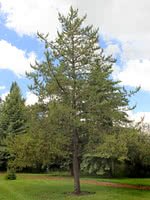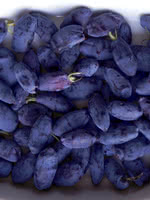Mon-Fri 9am - 5pm Mountain time
Cart reopens in November
Subscribe to our email list
to stay updated
Jack Pine vs Honey Bee Haskap (Honeyberry)
Pinus banksiana
Lonicera caerulea Honey Bee
COMING SOON
(new stock expected: fall of 2024)
COMING SOON
(new stock expected: fall of 2024)
Jack Pine is a cold tolerant native species that can survive on dry, sandy or gravelly sites.
Similar to Scots Pine, though somewhat larger, Jack Pine is known for its yellow-green needles, spreading crown, and irregular form. If you have a tough site to plant, this tree may be right for you.
Honey Bee Haskap produces tarter fruit than the Aurora and Borealis varieties and is known for bearing fruit at a younger age. The flavour of Haskaps is generally described as a cross between a blueberry and a raspberry. Honey Bee Haskaps are well suited to fresh eating, freezing, baking, and preserves.
The Honey Bee Haskap has stronger fruit holds than other varieties so the berries stay on the bush longer. The berries do not roll well so they are not recommended for mechanical harvesting.
Cross-pollination is required for Haskaps to set fruit. They need to be planted with a compatible variety. Compatibility is influenced by both bloom time and genetics.
Honey Bee Haskap is an early-pollinating variety and pairs well with Aurora, Borealis, Tundra, and Indigo Gem.
Jack Pine Quick Facts
Honey Bee Haskap (Honeyberry) Quick Facts
In row spacing: 3 - 4 m (10 - 12 ft)

